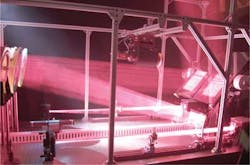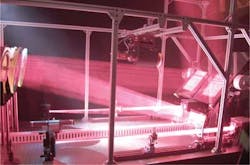UNMANNED VEHICLES: Vision-guided laser beaming powers remote vehicles
Traditionally, electric power has been transmitted over copper wires that are expensive to install, require significant installation time, and are subject to intermittent failure. More importantly, however, there are many places where electrical power lines are impractical, such as powering unmanned aerial vehicle (UAVs), or uneconomical, for example, where power must be delivered to distant, remote locations.
To overcome these obstacles, Carsten Erickson, tracking system lead at LaserMotive (Seattle, WA, USA; http://lasermotive.com) and his colleagues have developed a system based on laser power beaming: the wireless transfer of energy over long distances using laser light. In these systems, laser light is first shaped by a set of optics to define the beam size at its destination and then accurately directed toward a photovoltaic receiver that converts the light into electricity on a remote vehicle.
"To power a UAV in-flight demands a closed-loop system that can accurately move and track the position of the laser as the vehicle moves," says Erickson. "To accomplish this, the system must accurately position the beam onto the photovoltaic receiver and move the beam dynamically." Thus by closing the predicted and actual flight position, the system can track the vehicle and deliver the necessary laser power required.
Recently, at the Future of Flight Aviation Center (Mukilteo, WA, USA), LaserMotive demonstrated how a laser-powered beaming system could be used to power a vertical takeoff and landing (VTOL) quadrocopter for more than 12 hours. A 1000-W laser-diode stack from Dilas (Tucson, AZ, USA; www.dilas.com) was focused onto a parabolic mirror to accomplish this process automatically. Focused light from this mirror then impinges onto a flat mirror that, under control of an x-y positioning system, is used to direct the laser light toward the photovoltaic receiver on the UAV.
Two P70530 300-W stepper drivers from National Instruments (NI; Austin, TX, USA; www.ni.com) were interfaced to an NI-7344 motion controller to control the two-stepper motors used for x-y positioning of the mirror.
To obtain positional information about the location of the quadrocopter, the closed-loop system also requires a means to monitor the position of the UAV in flight and adjust the position of the beam accordingly. A Prosilica GX Gigabit Ethernet camera from Allied Vision Technologies (AVT; Stadtroda, Germany; www.alliedvisiontec.com) fitted with a 22x zoom lens from Fujinon (Wayne, NJ, USA; www.fujifilmusa.com) is used to image the position of the laser beam on the mirror (see figure).
Images captured by this camera are then transferred at 80 frames/s over the camera's Gigabit Ethernet interface to an NI-3100 industrial controller. To form a closed-loop system, the NI-3100 was also interfaced to NI-7344 motion controller. In this way, feedback from the reflected laser light and vehicle marking lights from the UAV are used to compute the location of the quadrocopter and to steer the mirror using the x-y servomotors.
To evaluate the reflected light from the quadrocopter, digitized images were analyzed on the NI-3100 industrial controller using IMAQ Vision. After thresholding the image to remove background information, blob analysis was performed on the images to locate the center position of the UAV. Analyzing the size of the reflected images also allowed the system to estimate the elevation of the UAV.
While this type of laser beam steering allows UAVs to be remotely powered, the power transfer still remains only approximately 25% as efficient as power transmission over wires. Erickson says with improved lasers and photovoltaics, in the future this efficiency is expected to increase the applicability of the technology for operations such as powering communication satellites and lunar rovers.

